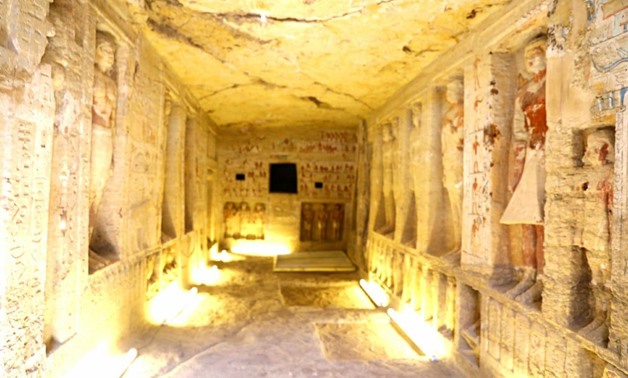
An “exceptionally well-preserved” tomb belonging to a Fifth Dynasty royal priest was discovered at Saqqara by an Egyptian archaeological mission on Saturday - Egypt Today.
CAIRO – 17 December 2018: An “exceptionally well-preserved” tomb that belongs to a Fifth Dynasty royal priest was discovered at Saqqara by an Egyptian archaeological mission on Saturday, Dec. 15.
The tomb discovery grabbed the attention of several acclaimed international newspapers.
"Though this may be the first tomb of its kind unearthed in 2018, Egypt has explored a variety of impressive artifacts and locations this year," stated The Newsweek.
"The tomb belongs to Wahtye, a high priest who served during the reign of King Neferirkare of the Fifth dynasty," according to The Telegraph.
"Archaeologists have discovered a well-preserved, 4400 – year-old tomb of a royal priest and his family in Egypt, in a ‘one of a kind’ find," The New York Times wrote.
"His tomb is decorated with scenes showing the royal priest alongside his mother, wife and other members of his family," according to The Gulf Today.
"Egypt unveiled a well-preserved 4,400-year-old tomb decorated with hieroglyphs and statues south of Cairo on Saturday, and officials expect more discoveries when archaeologists excavate the site further in the coming months," Reuters wrote.
"The tomb dates from the rule of Neferirkare Kakai, the third king of the Fifth Dynasty of the Old Kingdom. It contains more than a dozen niches and 24 colourful statues of the cleric and members of his family," according to Daily Mail.
The tomb was uncovered at the Sacred Animal Necropolis in Saqqara. Antiquities Minister Khaled Anany announced in an event held on Saturday that the discovered tomb is to a royal purification priest named Wahtye from the reign of King Nefer Ir-Ka-Re.
Anany explained that the discovered tomb is exceptionally well-preserved and painted, with walls decorated with colourful scenes showing royal priest Wahtye with his mother, wife and family.
“It is the most beautiful tomb discovered this year,” Anany said.
Secretary-General of the Supreme Council of Antiquities and head of the excavation mission, Mostafa Waziri, said that the mission uncovered the tomb’s facade during its second excavation season in November, but was unable to enter it as the doors were sealed.
"We managed to remove the debris from the tomb’s façade, a lintel on top of the tomb’s door was revealed, engraved with three hieroglyphic lines: the name and different titles of the owner, who was a royal purification priest named Wahtye, the supervisor of King Nefer-Ir-Ka-Re and the inspector of the holy boat," Waziry recounted.
Waziri added that the tomb’s walls house a number of colored engravings showing the name of the royal purification priest’s wife Weret Ptah, and many scenes featuring Wahtye with his mother Merit Meen and his family, in addition to scenes depicting manufacturing pottery and wine, making religious offerings, musical performances, boats sailing, manufacturing funerary furniture, and hunting.
The mission uncovered 18 niches inside the tomb displaying 24 large colored statues carved in rock, showing the royal priest with his family.
The lower part of Wahtye’s tomb houses 26 small niches with 31 statues of a person standing, or in the seated scribe position. This person is not yet identified.
Waziri assumed that this person could be the priest or a member of his family.
The general director of the Saqqara archaeological site, Sabry Farag, said that the uncovered tomb houses a rectangular hall about 10 meters long from north to south, 3 meters wide from east to west, and about 3 meters high, with a basement at the end of the tomb.
Waziri said that the tomb also houses five burial shafts, as well as two false doors, one belonging to Wahtye and the other to his mother.
A notable group of foreign and Arab ambassadors and members of Egypt’s Parliament attended the event announcing the new discovery.
It is worth mentioning that a cemetery dating back to the 18th Dynasty (1550 BC -1292 BC) was unearthed during the excavation works of the Swedish archaeological mission at Gebel el-Silsilain Kom Ombo, Aswan, the Ministry of Antiquities declared on Thursday, December 13.
Waziri said that the undecorated tomb is located at a depth of 5 meters, and consists of a burial chamber and two stone blocks.
He referred that the cemetery was subjected to numerous theft attempts, which filled it with sand and silt; hence, the mission cannot assess the extent of damage that occurred at the site.
He added that the underground water filling the cemetery caused damage to the interior rooms and artifacts.


Comments
Leave a Comment